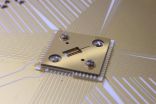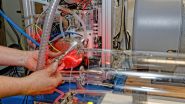INFORMATION:
About St. Michael's Hospital
St. Michael's Hospital provides compassionate care to all who enter its doors. The hospital also provides outstanding medical education to future health care professionals in more than 23 academic disciplines. Critical care and trauma, heart disease, neurosurgery, diabetes, cancer care, and care of the homeless are among the hospital's recognized areas of expertise. Through the Keenan Research Centre and the Li Ka Shing International Healthcare Education Centre, which make up the Li Ka Shing Knowledge Institute, research and education at St. Michael's Hospital are recognized and make an impact around the world. Founded in 1892, the hospital is fully affiliated with the University of Toronto.
Media contact
For more information, please contact:
Leslie Shepherd, Manager, Media Strategy,
St. Michael's Hospital
416-864-6094, shepherdl@smh.ca
http://www.stmichaelshospital.com
Follow us on Twitter: http://www.twitter.com/stmikeshospital
ER doctors stress need for good communications with police
Good working relationship with police essential for smooth operation of a busy ER
2015-05-26
(Press-News.org) TORONTO, May 27, 2015--A good working relationship with police is essential for the smooth operation of a busy Emergency Department. Police are in and out of EDs regularly, supporting EMS, transporting patients and helping to provide a safe environment for hospital staff.
Not surprisingly, differences of opinion arise from time to time over a health care worker's duty to protect patient privacy and the police need to conduct a criminal investigation.
That's why it's essential to develop strategies to optimize communications between police and ED workers, according to a paper published in the Canadian Journal of Emergency Medicine by ED physicians at St. Michael's Hospital.
Dr. Alun Ackery, an emergency physician and trauma team leader, said the two most common interactions between ED staff and police that highlight their different perspectives involve trauma patients and emotionally disturbed patients.
Trauma patients:
Physician perspective: The immediate priority for health-care workers is to assess the patient and obtain a complete medical history. Provincial laws require health care workers to protect patient confidentiality and personal health information. However, police sometimes overhear information about a patient or view parts of the chart, such as a blood alcohol level, simply by being present in an ED.
The law: Health-care workers may disclose personal health information without a patient's consent only if police obtain a search warrant or if it's necessary to prevent a significant risk of harm. Seven provinces, including Ontario, have mandatory gunshot wound reporting laws and the four Western provinces require hospitals to report stab wounds that are not self-inflicted.
Police perspective: The paper says police need early access to information to perform their investigations. Life-threatening injuries are treated as a possible homicide, requiring a different approach to forensics, evidence-gathering and investigative resources.
How to improve: Dr. Brodie Nolan, a third-year emergency resident at St. Michael's and the paper's lead author, said an attempt to obtain patient consent should be made before disclosure of any information to police. But if that's not possible, ED physicians can disclose limited information such as a patient's name, next of kin and medical status (stable, fair or critical). If police request more, "a pleasant reminder regarding patient confidentiality should suffice." Police requests to stay within view of a patient can be accommodated by having police remain outside of the room if there is a glass barrier or wait in an area where they can see the patient but not hear the conversation. Conflicts should be referred quickly to the appropriate hospital administrator, Dr. Nolan said.
Emotionally disturbed patients
The law: Each provincial Mental Health Act allows police to detain and escort people to hospital if police believe they are suffering from a mental illness. No information can be given to police with patient consent, unless there is an imminent risk of serious bodily harm or death to an identifiable person or group.
Physician perspective: Proper assessment of psychiatric patients takes time, especially if an involuntary admission is being considered.
Police perspective: The paper says patients accompanied by police may wait for hours in a busy ED before they can be assessed and transferred to a physician's care and the police officer can return to the community. Some EDs lack security or adequate mental health workers, meaning police may have to stay with some patients until they are admitted to in-patient psychiatric wards. Police can provide unique information regarding the state of the patient when he or she was detained, which can be helpful in filling out documents required for involuntary admission.
How to improve: The Human Services and Justice Coordinating Committee of Ontario, in conjunction with multiple regional health authorities and local police services, developed strategies for effective police-ED protocols, focused on improving communications and streamlining the process for patients brought in by police with a mental health crisis. Some hospitals have also developed an emotionally disturbed person information form, where police can describe their observations and information given to them by the patient before or during his or her trip to the hospital.
ELSE PRESS RELEASES FROM THIS DATE:
Changes in forest structure affect bees and other pollinators
2015-05-26
ATHENS, GA - Over the past century, many forests have shifted from open to closed canopies. The change in forest structure could be contributing to declines in pollinator species, especially native bees, according to a new study by U.S. Forest Service scientists.
The study shows how common present-day forest conditions affect pollinators, especially bees. "Bees prefer open forests," says Jim Hanula, a research entomologist at the Southern Research Station (SRS) Insects, Diseases, and Invasive Plants research unit. "We found that total tree basal area was the best predictor ...
Debunking 3 common food myths (video)
2015-05-26
WASHINGTON, May 26, 2015 -- You might have heard that microwaving your food is dangerous. Maybe your health nut friend told you that eating frozen veggies is less healthful than eating fresh ones. Is a glass of red wine really good for your heart? This week, Reactions is here to sort out the "old wives' tales" from the facts, taking on a swath of food myths. Check out the videos here: http://bit.ly/ACSFoodMyths.
Subscribe to the series at http://bit.ly/ACSReactions, and follow us on Twitter @ACSreactions to be the first to see our latest videos.
INFORMATION:
The ...
New urine test could reduce need for blood samples
2015-05-26
CLEMSON, S.C. -- If you've been to the doctor, you probably know what to do when you're handed a plastic cup and shown to the bathroom.
Most patients hand over the sample and give little thought to what happens when it's shipped to the lab for analysis.
Ken Marcus and his students are the exceptions. They have developed a new testing method that they believe will reduce costs, get faster results and lower the volume of urine needed for a sample.
Marissa Pierson, a master's student, closes the lid on a centrifuge while working in a Clemson University lab with Ken Marcus.
It's ...
Squeezed quantum cats
2015-05-26
This news release is available in German.
Quantum physics is full of fascinating phenomena. Take, for instance, the cat from the famous thought experiment by the physicist Erwin Schrodinger. The cat can be dead and alive at once, since its life depends on the quantum mechanically determined state of a radioactively decaying atom which, in turn, releases toxic gas into the cat's cage. As long as one hasn't measured the state of the atom, one knows nothing about the poor cat's health either - atom and kitty are intimately "entangled" with each other.
Equally striking, ...
Researchers solve another piece of the puzzle how forests can effect our climate
2015-05-26
This news release is available in German.
Leipzig / Helsinki. A first global scale study has estimated how forest emitted compounds affecting cloud seeds via formation of low-volatility vapours. According to the latest projections, terrestrial vegetation emits several million tons of extremely low-volatility organic compounds (ELVOCs) per year to the atmosphere. These oxidation products of compounds such as monoterpenes results in an increase of condensing vapours that can further form cloud condensation nuclei over the continents and thus has an influence ...
A scientific breakthrough helps explain how DNA is organized in our cells
2015-05-26
Montréal, May 25, 2015 - A team of researchers at the IRCM led by François Robert, PhD, uncovered a critical role for two proteins in chromatin structure. Their breakthrough, recently published in the scientific journal Molecular Cell, helps explain how DNA is organized in our cells. This discovery could lead to a better understanding of what causes certain types of cancer, such as lymphoma.
Dr. Robert and his team study chromatin, the structure composed of DNA and proteins that makes up chromosomes. Its main role is to package DNA molecules containing all the ...
Nanotechnology identifies brain tumor types through MRI 'virtual biopsy' in animal studies
2015-05-26
LOS ANGELES (May 26, 2015) - Biomedical researchers at Cedars-Sinai have invented a tiny drug-delivery system that can identify cancer cell types in the brain through "virtual biopsies" and then attack the molecular structure of the disease.
If laboratory research with mice is borne out in human studies, the results could be used to deliver nano-scale drugs that can distinguish and fight tumor cells in the brain without resorting to surgery.
"Our nanodrug can be engineered to carry a variety of drugs, proteins and genetic materials to attack tumors on several fronts ...
Monitoring magnetospheres
2015-05-26
Queen's University PhD student Matt Shultz is researching magnetic, massive stars, and his research has uncovered questions concerning the behaviour of plasma within their magnetospheres.
Drawing upon the extensive dataset assembled by the international Magnetism in Massive Stars (MiMeS) collaboration, led by Mr. Shultz's supervisor, Queen's professor Gregg Wade, along with some of his own observations collected with both the Canada-France-Hawaii Telescope and the European Southern Observatory's Very Large Telescope, Mr. Shultz is conducting the first systematic population ...
Researchers identify new target for Ebola drugs
2015-05-26
Washington, D.C. -- May 26, 2015 -- A new study has demonstrated that a protein called Niemann-Pick C1 (NPC1) is critical for the Ebola virus to infect a host. The study, published in the May/June issue of mBio, the online open-access journal of the American Society for Microbiology, suggests that drugs that block NPC1 could be used to treat this deadly disease.
"The science behind the concept of blocking the interaction between NPC1 and the virus is solid. Now, it is just a matter of powering through and identifying drugs that can inhibit NPC1 and moving them forward," ...
Study identifies Ebola virus's Achilles' heel
2015-05-26
An international team including scientists from Albert Einstein College of Medicine of Yeshiva University and the U.S. Army Medical Research Institute of Infectious Diseases (USAMRIID) has identified the molecular "lock" that the deadly Ebola virus must pick to gain entry to cells. The findings, made in mice, suggest that drugs blocking entry to this lock could protect against Ebola infection. The study was published in today's edition of the online journal mBio.
The researchers found that the Ebola virus can't infect cells unless it first attaches to a host protein called ...
LAST 30 PRESS RELEASES:
There are new antivirals being tested for herpesviruses. Scientists now know how they work
CDI scientist, colleagues author review of global burden of fungus Candida auris
How does stroke influence speech comprehension?
B cells transiently unlock their plasticity, risking lymphoma development
Advanced AI dodel predicts spoken language outcomes in deaf children after cochlear implants
Multimodal imaging-based cerebral blood flow prediction model development in simulated microgravity
Accelerated streaming subgraph matching framework is faster, more robust, and scalable
Gestational diabetes rose every year in the US since 2016
OHSU researchers find breast cancer drug boosts leukemia treatment
Fear and medical misinformation regarding risk of progression or recurrence among patients with breast cancer
Glucagonlike peptide-1 receptor agonists and asthma risk in adolescents with obesity
Reviving dormant immunity: Millimeter waves reprogram the immunosuppressive microenvironment to potentiate immunotherapy without obvious side effects
Safety decision-making for autonomous vehicles integrating passenger physiological states by fNIRS
Fires could emit more air pollution than previously estimated
A new way to map how cells choose their fate
Numbers in our sights affect how we perceive space
SIMJ announces global collaborative book project in commemoration of its 75th anniversary
Air pollution exposure and birth weight
Obstructive sleep apnea risk and mental health conditions among older adults
How talking slows eye movements behind the wheel
The Ceramic Society of Japan’s Oxoate Ceramics Research Association launches new international book project
Heart-brain connection: international study reveals the role of the vagus nerve in keeping the heart young
Researchers identify Rb1 as a predictive biomarker for a new therapeutic strategy in some breast cancers
Survey reveals ethical gaps slowing AI adoption in pediatric surgery
Stimulant ADHD medications work differently than thought
AI overestimates how smart people are, according to HSE economists
HSE researchers create genome-wide map of quadruplexes
Scientists boost cell "powerhouses" to burn more calories
Automatic label checking: The missing step in making reliable medical AI
Low daily alcohol intake linked to 50% heightened mouth cancer risk in India
[Press-News.org] ER doctors stress need for good communications with policeGood working relationship with police essential for smooth operation of a busy ER


